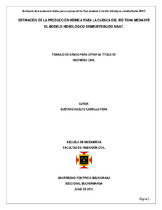| dc.contributor.advisor | Villamizar Amaya, Sandra Rocío | |
| dc.contributor.author | Carrillo Peña, Gustavo Adolfo | |
| dc.coverage.temporal | 2018 | |
| dc.date.accessioned | 2020-06-01T14:51:28Z | |
| dc.date.available | 2020-06-01T14:51:28Z | |
| dc.date.issued | 2018 | |
| dc.identifier.uri | http://hdl.handle.net/20.500.11912/5505 | |
| dc.description | 93 páginas | spa |
| dc.description.abstract | La modelación hidrológica puede ser usada para comprender los procesos más determinantes en la producción hídrica de una cuenca y de esta manera enfocar las actividades de manejo de esta. Este estudio utilizó el modelo hidrológico semidistribuido SWAT para determinar la producción hídrica de una cuenca ante diferentes escenarios de uso de suelo y climatológicos. La cuenca de estudio es la del río Tona (Santander, Colombia) que es la fuente principal de abastecimiento para el área metropolitana de Bucaramanga. El estudio conllevó esfuerzos importantes en (1) conocer la estructura y funcionamiento de la herramienta de modelación, (2) obtener, analizar y preparar los datos necesarios para correr el modelo, (3) definir la mejor estrategia de calibración y validación, (4) correr del modelo para diferentes escenarios de clima y cambios en el uso del suelo. Los resultados obtenidos permitieron comparar la producción hídrica para condiciones actuales (período 1987-2002) con condiciones futuras (2006-2050) de uso del suelo y climatología (modelo climatológico escalado MIR005, escenarios RCP 4.5 Y 8.5). La modelación de escenarios futuros permitió obtener valores globales de producción hídrica para la cuenca (promedios anuales de producción hídrica) y determinar, a nivel de subcuenca, las áreas estratégicas donde se pueden enfocar las actividades de conservación y protección por parte de los manejadores del recurso hídrico. | spa |
| dc.description.abstract | Hydrologic modelling can be used to understand the most determinant processes related to water yield within a watershed and hence better focus the management efforts put on it. This study used the semidistributed hydrological model SWAT to evaluate a watershed's water yield in the context of different land use and climate scenarios. The watershed of interest for this study is Tona (located in Santander, Colombia), the most important source of water for the metropolitan area of Bucaramanga. This study implied important efforts in (1) getting to know the structure and working of the modelling tool, (2) obtaining, analyzing, and preparing all the data necessary to run the model, (3) defining the best strategy for model's calibration and validation, (4) running the model for the different land use and climate scenarios. The results of the study allowed to compare water yield estimates for current conditions (1987-2002 period) with those of future ones (2006-2050 period) for land use and climate (future scenarios were obtained from the downscaled climate model MIR005, RCP 4.5 and 8.5). The modelling effort for future scenarios produced global estimates of the basin's water yield (average annual values) and, at the subbasin level, allowed to identify strategic areas where the protection and conservation activities of the basin's water managers can be focused. | eng |
| dc.format.mimetype | application/pdf | |
| dc.language.iso | spa | |
| dc.publisher | Universidad Pontificia Bolivariana | spa |
| dc.rights | Attribution-NonCommercial-NoDerivatives 4.0 International | * |
| dc.rights.uri | http://creativecommons.org/licenses/by-nc-nd/4.0/ | * |
| dc.title | Estimación de la producción hídrica para la cuenca del río Tona mediante el modelo hidrológico semidistribuido swat | spa |
| dc.type | Práctica | spa |
| dc.publisher.department | Escuela de Ingenierías | spa |
| dc.publisher.program | Ingeniería Civil | spa |
| dc.type.hasVersion | publishedVersion | spa |
| dc.description.sectional | Bucaramanga | spa |
| dc.description.degreename | Ingeniero Civil | spa |


